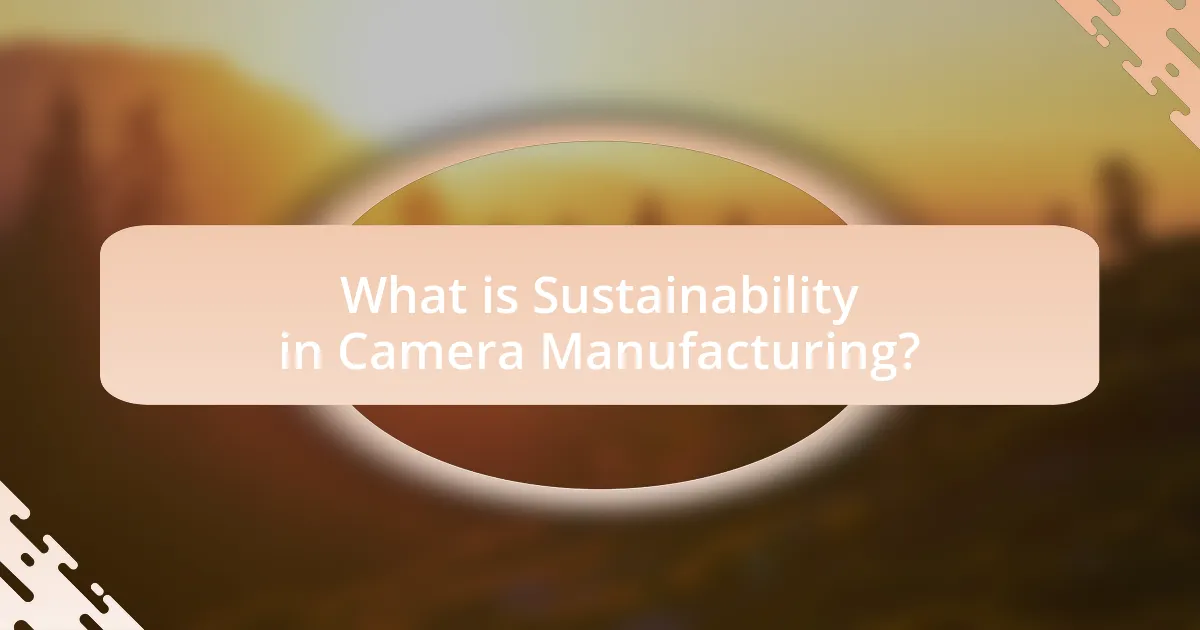Sustainability in camera manufacturing encompasses practices aimed at minimizing environmental impact throughout the product lifecycle, including the use of eco-friendly materials and energy-efficient production methods. Key players like Canon and Nikon are adopting sustainable practices to meet consumer demand for environmentally responsible products, as over 70% of consumers prefer brands with sustainability initiatives. The article explores the environmental impacts of traditional camera manufacturing, the importance of sustainability, current trends, and the challenges manufacturers face in implementing eco-friendly practices. Additionally, it highlights how consumer expectations are shaping the industry and the future prospects for sustainable camera technology.

What is Sustainability in Camera Manufacturing?
Sustainability in camera manufacturing refers to the practices and processes that minimize environmental impact throughout the lifecycle of camera products. This includes using eco-friendly materials, reducing energy consumption during production, and implementing recycling programs for end-of-life products. For instance, companies like Canon and Nikon have adopted sustainable practices by utilizing recycled plastics and reducing greenhouse gas emissions in their manufacturing processes. These efforts align with consumer expectations for environmentally responsible products, as studies show that over 70% of consumers prefer brands that demonstrate sustainability initiatives.
Why is sustainability important in the camera manufacturing industry?
Sustainability is important in the camera manufacturing industry because it addresses environmental concerns and meets consumer demand for eco-friendly products. The production of cameras often involves the use of hazardous materials and generates significant waste, which can harm ecosystems. By adopting sustainable practices, manufacturers can reduce their carbon footprint, minimize resource depletion, and promote recycling initiatives. For instance, companies like Canon and Nikon have implemented programs to recycle old cameras and reduce plastic usage in packaging, reflecting a growing trend towards sustainability that aligns with consumer expectations for responsible manufacturing.
What environmental impacts are associated with traditional camera manufacturing?
Traditional camera manufacturing is associated with several environmental impacts, including resource depletion, pollution, and waste generation. The production process requires significant amounts of raw materials, such as metals and plastics, which contribute to habitat destruction and resource scarcity. Additionally, the manufacturing process often involves the use of hazardous chemicals that can lead to air and water pollution. For instance, the production of electronic components generates toxic e-waste, which poses risks to both human health and the environment. According to a study by the United Nations University, e-waste is projected to reach 74 million metric tons by 2030, highlighting the growing concern over waste management in electronics, including cameras.
How does sustainability address these environmental impacts?
Sustainability addresses environmental impacts in camera manufacturing by promoting practices that reduce waste, conserve resources, and minimize carbon emissions. For instance, sustainable manufacturing processes often incorporate recycled materials, which lowers the demand for virgin resources and reduces landfill waste. Additionally, energy-efficient production methods decrease greenhouse gas emissions, contributing to a smaller carbon footprint. Research indicates that companies adopting sustainable practices can reduce their environmental impact by up to 30%, as seen in the case of camera manufacturers implementing eco-friendly technologies and materials.
What are the key trends in sustainable camera manufacturing?
Key trends in sustainable camera manufacturing include the use of eco-friendly materials, energy-efficient production processes, and a focus on product longevity. Manufacturers are increasingly adopting recycled plastics and biodegradable materials to reduce environmental impact. For instance, companies like Canon and Nikon have initiated programs to incorporate recycled materials into their camera bodies, aiming for a significant percentage of recycled content in future models. Additionally, energy-efficient manufacturing techniques are being implemented to minimize carbon footprints, with some brands committing to renewable energy sources for their production facilities. Furthermore, there is a growing emphasis on designing cameras for durability and repairability, which aligns with the circular economy principles, thereby extending product life and reducing waste.
How are manufacturers adopting eco-friendly materials?
Manufacturers are adopting eco-friendly materials by integrating sustainable practices into their production processes. This includes using recycled plastics, biodegradable materials, and sustainably sourced components to reduce environmental impact. For instance, companies like Canon and Nikon have implemented initiatives to incorporate recycled materials into their camera bodies, with Canon reporting that 40% of its camera materials are now recycled. Additionally, manufacturers are increasingly focusing on reducing carbon footprints by optimizing supply chains and utilizing renewable energy sources in their operations.
What innovations are being implemented to reduce waste in production?
Innovations being implemented to reduce waste in production include the adoption of circular economy principles, advanced manufacturing technologies, and sustainable materials. Circular economy practices focus on designing products for longevity and recyclability, which minimizes waste at the end of a product’s life cycle. Advanced manufacturing technologies, such as 3D printing and automation, enhance precision and efficiency, reducing material waste during production. Additionally, the use of sustainable materials, like biodegradable plastics and recycled metals, further decreases environmental impact. According to a report by the Ellen MacArthur Foundation, transitioning to a circular economy could reduce global waste by up to 70% by 2030, demonstrating the effectiveness of these innovations in waste reduction.
How are consumer expectations shaping sustainability in camera manufacturing?
Consumer expectations are significantly shaping sustainability in camera manufacturing by driving companies to adopt eco-friendly practices and materials. As consumers increasingly prioritize environmental responsibility, manufacturers are responding by implementing sustainable sourcing of materials, reducing carbon footprints, and enhancing product recyclability. For instance, a survey by Nielsen found that 73% of millennials are willing to pay more for sustainable products, prompting camera brands to innovate in areas such as biodegradable packaging and energy-efficient production processes. This shift not only meets consumer demand but also positions companies competitively in a market that values sustainability.
What do consumers prioritize when it comes to sustainable cameras?
Consumers prioritize eco-friendly materials, energy efficiency, and ethical manufacturing practices when it comes to sustainable cameras. Research indicates that 66% of consumers are willing to pay more for sustainable products, highlighting the importance of environmentally responsible sourcing and production methods. Additionally, features such as recyclability and reduced carbon footprint are increasingly significant, as consumers seek products that align with their values on sustainability.
How are consumer preferences influencing manufacturers’ sustainability practices?
Consumer preferences are significantly influencing manufacturers’ sustainability practices by driving demand for eco-friendly products and transparent supply chains. As consumers increasingly prioritize sustainability, manufacturers are compelled to adopt practices such as using recycled materials, reducing carbon footprints, and ensuring ethical sourcing. For instance, a 2021 survey by Nielsen found that 73% of global consumers are willing to change their consumption habits to reduce environmental impact, prompting camera manufacturers to innovate and align their offerings with these values. This shift not only enhances brand loyalty but also positions companies competitively in a market that increasingly favors sustainable practices.

What are the challenges in achieving sustainability in camera manufacturing?
Achieving sustainability in camera manufacturing faces several challenges, including resource extraction, energy consumption, and waste management. The extraction of rare materials, such as lithium and cobalt for batteries, often leads to environmental degradation and ethical concerns regarding labor practices. Additionally, the manufacturing process is energy-intensive, contributing to carbon emissions; for instance, the production of electronic components can account for up to 80% of a product’s total carbon footprint. Finally, waste management poses a significant issue, as electronic waste from outdated or broken cameras can lead to pollution if not properly recycled. These factors collectively hinder the transition to sustainable practices in the camera manufacturing industry.
What barriers do manufacturers face in adopting sustainable practices?
Manufacturers face several barriers in adopting sustainable practices, primarily including high initial costs, lack of consumer demand, and insufficient regulatory support. High initial costs deter manufacturers from investing in sustainable technologies and materials, as they often require significant upfront capital. Additionally, a lack of consumer demand for sustainable products can lead manufacturers to prioritize cost-cutting over sustainability, as they may not see a clear return on investment. Furthermore, insufficient regulatory support can create an environment where there is little incentive for manufacturers to change their practices, as they may not face penalties for unsustainable operations. These barriers collectively hinder the transition to more sustainable manufacturing processes in the camera industry.
How do costs impact the transition to sustainable manufacturing?
Costs significantly impact the transition to sustainable manufacturing by influencing investment decisions and operational feasibility. High initial costs associated with adopting sustainable technologies and processes can deter manufacturers from making the switch, as they often prioritize short-term financial returns over long-term sustainability benefits. For instance, a study by the Ellen MacArthur Foundation indicates that transitioning to circular economy practices can require substantial upfront investment, which may not be immediately recouped through cost savings or increased sales. Additionally, ongoing operational costs, such as sourcing sustainable materials or implementing energy-efficient systems, can further complicate the financial landscape for manufacturers. Therefore, the financial implications of these costs play a crucial role in determining the pace and extent of the shift towards sustainable manufacturing practices.
What role does technology play in overcoming these challenges?
Technology plays a crucial role in overcoming sustainability challenges in camera manufacturing by enabling more efficient production processes and reducing waste. Advanced manufacturing technologies, such as 3D printing and automation, allow for precise material usage, minimizing excess and optimizing resource consumption. For instance, a study by the International Journal of Advanced Manufacturing Technology found that implementing 3D printing can reduce material waste by up to 90% compared to traditional methods. Additionally, innovations in energy-efficient components and renewable energy sources for production facilities further decrease the carbon footprint of camera manufacturing. These technological advancements not only address environmental concerns but also align with consumer expectations for sustainable products, driving the industry towards more responsible practices.
How can collaboration enhance sustainability efforts in the industry?
Collaboration can enhance sustainability efforts in the camera manufacturing industry by facilitating resource sharing, innovation, and best practices among companies. When manufacturers collaborate, they can pool resources to invest in sustainable technologies, such as energy-efficient production processes and eco-friendly materials. For instance, partnerships between companies can lead to the development of shared supply chains that minimize waste and reduce carbon footprints. Additionally, collaborative initiatives, such as industry-wide sustainability standards, can drive collective action towards reducing environmental impacts. Research from the Ellen MacArthur Foundation highlights that collaborative approaches can significantly accelerate the transition to a circular economy, which is crucial for sustainability in manufacturing.
What partnerships are essential for promoting sustainable practices?
Collaborations between camera manufacturers, environmental organizations, and governmental bodies are essential for promoting sustainable practices. These partnerships facilitate the sharing of resources, knowledge, and best practices that drive innovation in sustainable materials and production processes. For instance, collaborations with environmental organizations can lead to the development of eco-friendly manufacturing techniques, while partnerships with governments can result in favorable policies and incentives for sustainable practices. Such alliances have been shown to enhance corporate social responsibility and improve brand reputation, ultimately leading to increased consumer trust and market competitiveness in the camera manufacturing industry.
How can industry standards drive sustainability in camera manufacturing?
Industry standards can drive sustainability in camera manufacturing by establishing benchmarks for environmental performance and resource efficiency. These standards, such as ISO 14001 for environmental management systems, encourage manufacturers to adopt practices that minimize waste, reduce energy consumption, and utilize sustainable materials. For instance, adherence to these standards can lead to the implementation of recycling programs and the use of eco-friendly packaging, which have been shown to significantly lower the carbon footprint of production processes. Furthermore, compliance with industry standards can enhance brand reputation and meet consumer demand for sustainable products, as evidenced by a 2021 survey indicating that 73% of consumers are willing to pay more for environmentally friendly products.

What are the future prospects for sustainability in camera manufacturing?
The future prospects for sustainability in camera manufacturing are promising, driven by advancements in eco-friendly materials and energy-efficient production processes. Manufacturers are increasingly adopting sustainable practices, such as using recycled plastics and reducing carbon footprints, to meet growing consumer demand for environmentally responsible products. For instance, companies like Canon and Nikon have committed to sustainability goals, including reducing greenhouse gas emissions by 30% by 2030. Additionally, the integration of circular economy principles, where products are designed for longevity and recyclability, is becoming a standard practice in the industry. These trends indicate a significant shift towards sustainability, aligning with global efforts to combat climate change and promote responsible consumption.
How is the market for sustainable cameras expected to evolve?
The market for sustainable cameras is expected to grow significantly as consumer demand for eco-friendly products increases. This growth is driven by heightened awareness of environmental issues and a shift towards sustainable practices in various industries, including photography. According to a report by ResearchAndMarkets, the global sustainable camera market is projected to expand at a compound annual growth rate (CAGR) of over 10% from 2023 to 2030. This trend is further supported by manufacturers adopting sustainable materials and production processes, aligning with consumer expectations for environmentally responsible products.
What innovations are on the horizon for sustainable camera technology?
Innovations on the horizon for sustainable camera technology include the development of biodegradable materials for camera bodies and components, as well as advancements in energy-efficient imaging sensors. Biodegradable materials, such as bioplastics derived from renewable resources, are being researched to reduce plastic waste in camera manufacturing. Energy-efficient imaging sensors, like those utilizing organic photodetectors, promise to lower power consumption significantly, enhancing battery life and reducing the environmental impact during use. These innovations are supported by ongoing research in materials science and engineering, indicating a shift towards more eco-friendly practices in the camera industry.
How can manufacturers prepare for future consumer demands regarding sustainability?
Manufacturers can prepare for future consumer demands regarding sustainability by adopting eco-friendly materials and implementing sustainable production processes. Research indicates that 66% of global consumers are willing to pay more for sustainable brands, highlighting the importance of aligning product offerings with consumer values. Additionally, manufacturers can invest in renewable energy sources and enhance supply chain transparency to meet the growing demand for ethical practices. By integrating these strategies, manufacturers not only respond to consumer expectations but also contribute to environmental conservation, thereby positioning themselves competitively in the market.
What best practices can manufacturers adopt to enhance sustainability?
Manufacturers can enhance sustainability by adopting practices such as implementing energy-efficient technologies, utilizing sustainable materials, and optimizing supply chain logistics. Energy-efficient technologies, like LED lighting and advanced machinery, can reduce energy consumption by up to 30%, significantly lowering carbon footprints. Utilizing sustainable materials, such as recycled plastics and biodegradable components, minimizes waste and resource depletion. Additionally, optimizing supply chain logistics through strategies like local sourcing and efficient transportation can reduce emissions and improve overall sustainability. These practices not only contribute to environmental preservation but also align with growing consumer expectations for sustainable products in the camera manufacturing industry.
How can lifecycle assessments improve sustainability in camera design?
Lifecycle assessments can improve sustainability in camera design by systematically evaluating the environmental impacts of a camera throughout its entire lifecycle, from raw material extraction to disposal. This comprehensive analysis enables designers to identify areas where resource use can be minimized, waste can be reduced, and energy efficiency can be enhanced. For instance, a study by the International Journal of Life Cycle Assessment found that optimizing materials and manufacturing processes can lead to a reduction of up to 30% in carbon emissions associated with product lifecycle. By implementing findings from lifecycle assessments, manufacturers can create more sustainable camera designs that align with consumer expectations for environmentally responsible products.
What role does consumer education play in promoting sustainable camera choices?
Consumer education plays a crucial role in promoting sustainable camera choices by informing buyers about the environmental impact of their purchases. Educated consumers are more likely to consider factors such as energy efficiency, materials used, and the lifecycle of cameras, leading to more sustainable decisions. Research indicates that consumers who are aware of sustainability issues are 50% more likely to choose eco-friendly products, as highlighted in a study by the Nielsen Global Sustainability Report. This awareness drives demand for manufacturers to adopt sustainable practices, ultimately influencing the market towards greener options.